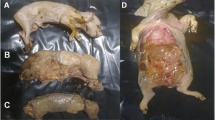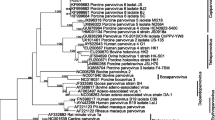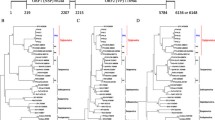Abstract
Background
Atypical porcine pestivirus (APPV) is a novel, highly variable porcine pestivirus. Previous reports have suggested that the virus is associated with congenital tremor (CT) type A-II in piglets, and little information is available about the correlation between the virus and sow abortion, or on coinfection with other viruses. In China, reported APPV strains were mainly isolated from South China and Central China, and data about the APPV genome from northern China are relatively scarce.
Methods
Eleven umbilical cords, one placenta, and one aborted piglet, were collected from aborted sows of the same farm in Shandong Province of northern China. Nucleic acids were extracted from the above samples, and subsequently pooled for viral metagenomics sequencing and bioinformatics analysis. The viral coexistence status and complete genome characteristics of APPV in Shandong Province were determined.
Results
In abortion cases, APPV was present with Getah virus, porcine picobirnavirus, porcine kobuvirus, porcine sapovirus, Po-Circo-like virus, porcine serum-associated circular virus, porcine bocavirus 1, porcine parvovirus 1, porcine parvovirus 3 and porcine circovirus 3, etc. The first complete genome sequence(11,556 nt) of APPV in Shandong Province of northern China, was obtained using viral metagenomics and designated APPV-SDHY-2022. Comparison with Chinese reference strains revealed that the polyprotein of APPV-SDHY-2022 shared 82.6-84.2%, 93.2-93.6%, and 80.7-85% nucleotide identity and 91.4-92.4%, 96.4-97.7%, and 90.6-92.2% amino acid identity with those of the Clade I, Clade II and Clade III strains, respectively. Phylogenetic analysis based on the complete polyprotein CDS and NS5A sequences concluded that APPV-SDHY-2022 belongs to Clade II. Analysis of the NS5A nucleotide sequences revealed homology of greater than 94.6% for the same isoform, 84.7-94.5% for different isoforms of the same clade and 76.8-81.1% for different clades. Therefore, Clade II was further divided into three subclades, and APPV-SDHY-2022 belonged to subclade 2.3. Members of Clade II have 20 unique amino acids in individual proteins, distinguishing them from Clade I and Clade III members. The E2 protein showed the greatest diversity of putative N-glycosylation sites with 9 patterns, and APPV-SDHY-2022 along with other Chinese APPV strains shared the conserved B-cell conformational epitope residues 39E, 70R, 173R, 190K and 191N of the E2 protein.
Conclusions
We reported viral coexistence and the first complete genome sequence of APPV from abortion cases and from Shandong Province. The new APPV isolate belongs to an independent branch of Clade II. Our results increase the molecular and epidemiological understanding of APPV in China.
Similar content being viewed by others
Background
Atypical porcine pestivirus (APPV) belongs to the genus Pestivirus in the family Flaviviridae and is a novel, highly differentiated pestivirus that was first identified in pigs in the USA through metagenomic sequencing in 2015 [1]. APPV was classified as Pestivirus K by the International Committee on Taxonomy of Viruses (ICTV) in 2018 [2]. The clinical presentation of pigs infected with APPV is characterized by congenital tremor (CT) type A-II in piglets [3], while adult pigs may become viral carriers and shedders [4]. It is not surprising that APPVs are present and have become a major threat in China, which is an important country for pig farming and trade [5].
APPV is a highly variable single-stranded RNA virus, and its genome is approximately 11.0 kb in size and comprises a single open reading frame (ORF) flanked by untranslated regions (UTRs) at the 5’- and 3’-ends. The ORF encodes a continuous polyprotein, which is processed into 12 mature proteins, including four structural proteins (C, Erns, E1, and E2) and eight nonstructural proteins (Npro, P7, NS2, NS3, NS4A, NS4B, NS5A, and NS5B) [1]. The NS3 gene has been shown to be highly conserved in Chinese strains of APPV, while the NS5A, Npro and Erns genes are highly variable [6]. All of the Chinese strains can be classified into 3 genotypes (clades) and 5 subgenotypes (subclades) (1.2 and 1.4–1.7) within genotype 1 [6]. The genomic presence of APPV has been detected in pigs from southern China, including Guangdong, Guangxi, Guizhou, Jiangxi, Yunnan, Anhui and other provinces [ Phylogenetic analysis of Chinese APPV strains. Phylogenetic trees based on the nucleotide sequences of the complete polyprotein CDS (A) and the NS5A gene (B) were constructed by the neighbor-joining (NJ) method with 1,000 bootstrap replicates in MEGA11 software. The APPV-SDHY-2022 strain reported in this study is indicated with a red dot
Recombination analysis
To further explore the genetic evolution of APPV, potential recombination events were identified using Recombination Detection Program version 4 (RDP4) and then examined using SimPlot version 3.5.1. Among all available APPV strains, 8 strains (GD-DH01-2018, GD-BZ01-2018, JX-JM01-2018A01, GD2, GD-HJ-2017.04, GD-LN-2017.04, GD-CT4, and GD-MH01-2018) had potential genetic recombination events. Although NGS of APPV-SDHY-2022 confirmed recombination events of JX-JM01-2018A01 and GD-HJ-2017.04 by RDP4 (see Additional file 4: Table s4), no obvious genetic recombination in APPV-SDHY-2022 strains was observed by SimPlot software in this study (Fig. 3).
Recombination analysis of the complete genomes of the APPV-SDHY-2022 strain from Shandong Province. Potential recombination events were identified using Recombination Detection Program 4 (RDP4) and then examined using similarity plots and bootstrap analysis in Simplot 3.5.1. The major and minor parents were JX-JM01-2018A01 and GD-HJ-2017.04, respectively
Amino acid sequence analysis
Amino acid sequences of individual viral proteins of all the Chinese APPV strains were analyzed. No amino acid insertions or deletions were found in the APPV-SDHY-2022 strain. The amino acid sequences of the individual proteins were compared to identify those that differentiate Clade II from Clade I and Clade III, and 20 unique amino acids were found in Clade II strains (Fig. 4), among which, most sites were distributed on NS5A(7H,16A,69Q,131Q,152M,189I,280A,397F,437A) and NS5B(77V,139P,193P,231K,274A), and the remaining sites were on Npro (85D,120E), C(90K), Erns(91K,139Y) and NS3(30T). Interestingly, the amino acids at these unique sites were identical between Clade I and Clade III strains, demonstrating that it is possible to determine the type of strain by measuring these specific amino acids alone.
Glycosylation analysis
In this study, putative N-glycosylation sites in the three important glycoproteins, Erns, E1, and E2, in Chinese APPV strains were also predicted. APPV-SDHY-2022, along with most of the strains in Clade II, is heavily glycosylated, with a total of ten N-glycosylation sites (N104 in the E1 protein; N12, N26, N43, N64, and N99 in the Erns protein; N51,N64,N103, and N127 in the E2 protein) (Fig. 5). All the Chinese APPV strains had a conserved putative N-glycosylation site at N104 with a consensus N-I-T motif in the E1 protein. The putative N-glycosylation sites in the Erns and E2 proteins differed greatly among strains in different subclades, and 9 patterns of putative N-glycosylation sites were observed in E2 proteins, including N51 + N64 + N103, N64 + N103, N51 + N64 + N103 + N141, N51 + N64 + N127 + N103 + N141, N51 + N64 + N103 + N127, N64 + N103 + N127, N51 + N127, N51 + N64, N64 (Fig. 5). Among the N-glycosylation sites of E2 proteins, a putative site at N64 was highly conserved.
Antigen prediction
To analyze the effect of glycosylation sites on the antigenicity of the E2 protein, the antigenic index was determined by the Jameson-Wolf method in this study, and the results showed that aa positions at 1 ~ 9, 15 ~ 28, 34 ~ 44, 49 ~ 55, 62 ~ 82, 118 ~ 130, 136 ~ 158, 174 ~ 184, 188 ~ 196 and 200 ~ 205 of the E2 protein were the potential immunodominant regions. A comparison of the antigenic index within Chinese strains with and without a specific putative site showed that the putative N-glycosylation site at N51 had a negative effect on the antigenicity of the corresponding region (Fig. 6).
Antigenicity prediction for the E2 protein. The Jameson-Wolf algorithm, which combines secondary structure information with backbone flexibility to predict surface accessibility, was used to determine the predicted antigenic index, with a threshold value of 1.7. The putative N-glycosylation sites within the E2 sequences of Chinese APPV strains are shown as a blue arrow. Representative strains from different Clades/subclades or patterns of putative N-glycosylation sites were included, and the strains in each subclade with different patterns of putative N-glycosylation sites are underlined
To further analyze the effect of glycosylation sites on conformational epitopes of the E2 protein, BepiPred-3.0 was used to predict B-cell conformational epitopes. The results showed that the 15 most likely B-cell conformational epitope residues varied among different Clades/subclades or patterns of N-glycosylation sites, and 39E, 70R, 173R, 190K, and 191N were conserved residues among all Chinese strains (Table 4) (see also the graphical representations of the predicted epitopes in Fig. 7).
Conformational B-cell epitope prediction for the E2 protein. The potential B-cell conformational epitopes of the E2 protein in APPV Chinese strains were predicted by BepiPred-3.0, and the residues with scores above the threshold (default value is 0.1512) are predicted to be part of an epitope and colored in yellow on the graph (where Y-axes depict BepiPred-3.0 epitope scores and X-axes protein sequence positions). Shown is the graphical output of B-cell discontinuous epitope predictions for the E2 protein with APPV-SDHY-2022 as an example
Discussion
One phylogeographic analysis suggested that the APPV population possibly originated in the Netherlands and was introduced into China between 1837 and 2010 [23]. Guangdong is the main node of transmission, and the pattern of transmission of the Chinese lineage shows a trend of movement from south to north [23]. Thus, relatively few virulent strains have been found in northern China compared to southern China. To date, in northern China, only two strains, HBtl1701 and CHheb1701, from Hebei Province are available with complete CDSs in GenBank. The APPV-SDHY-2022 strain in this study is the first complete genome of APPV in Shandong Province of northern China, and our results contribute to a better understanding of APPV epidemiology in China.
Previously, most samples used for APPV detection were from CT cases with tissues (spleens, lymph nodes, etc.) or serum samples [4, 33]. Therefore, we examined the homology of NS5A nucleotide sequences, and we found that Clade II could further be subtyped and classified APPV-SDHY-2022 as subclade 2.3. This result indicated that there were highly variable regions in the whole genomic sequences, which would be a major challenge for molecular diagnosis and epidemiological investigation of APPV, and the conserved 5’ UTR regions may be a more ideal target for molecular detection [34].
A previous study suggested that recombination events occur between clades (Clades II and III) or within a clade (Clade I) [13]. In our recombination analysis of 51 APPV strains, no recombination event was observed in the APPV-SDHY-2022 strain from Shandong Province, and all eight recombinant strains were isolated in other provinces (Guangdong and Jiangxi) in China. For the amino acid analysis, no amino acid insertions or deletions were found within APPV-SDHY-2022 strain; interestingly, we found numerous amino acids specific to Clade II. By identifying specific amino acids, it is possible to determine the genotype of a virus strain, providing a novel approach for the rapid detection of virus genotypes.
Putative N-glycosylation sites in the three important glycoproteins in Chinese APPV strains were also predicted, since the glycosylation status of the pestivirus glycoproteins plays an important role in virulence [35]. The APPV-SDHY-2022 strain is heavily glycosylated and has ten N-glycosylation sites, similar to most of the strains in Clade II (APPV-China/SWU-DY/2018 or APPV/CNYJ/2018) [6]. For some viruses, such as PRRSV, N-glycosylation sites are related to vaccine protection. In APPV, the N-glycosylation sites in the three important glycoproteins may also have the same important biological characteristics, and the E2 protein exhibited the greatest diversity of N-glycosylation sites, which would create a major bottleneck in APPV vaccine design, since the E2 protein is the main immunogenic protein and the crucial target for APPV vaccine development [36, 37]. Our results showed 5 conserved residues (39E, 70R, 173R, 190K, 191N) of B-cell conformational epitopes among all Chinese strains, which could be targets for multiepitope subunit vaccine and monoclonal antibody preparation, since BepiPred-3.0 is trained on PDB crystal structures of ab-ag complexes, and to predict antigen residues that are in contact with an antibody [22].
APPV can infect both domestic pigs and wild boar populations via horizontal and vertical transmission, which can result in the loss of piglets and decrease in pig reproductive performance [38]. Due to the abovementioned complicated epidemiology and the enormous loss of infected swine herds, epidemiological research should be thoroughly continued, and vaccine research should be accelerated.
Conclusions
In summary, in this study, APPV was detected in placenta, umbilical cords and aborted piglet samples from abortion cases using viral metagenomic sequencing, and this is the first time that the whole genome of APPV has been detected in Shandong Province. As a result of the analysis, new ty** methods and genotype detection methods have been proposed, which form the basis for future related research.











